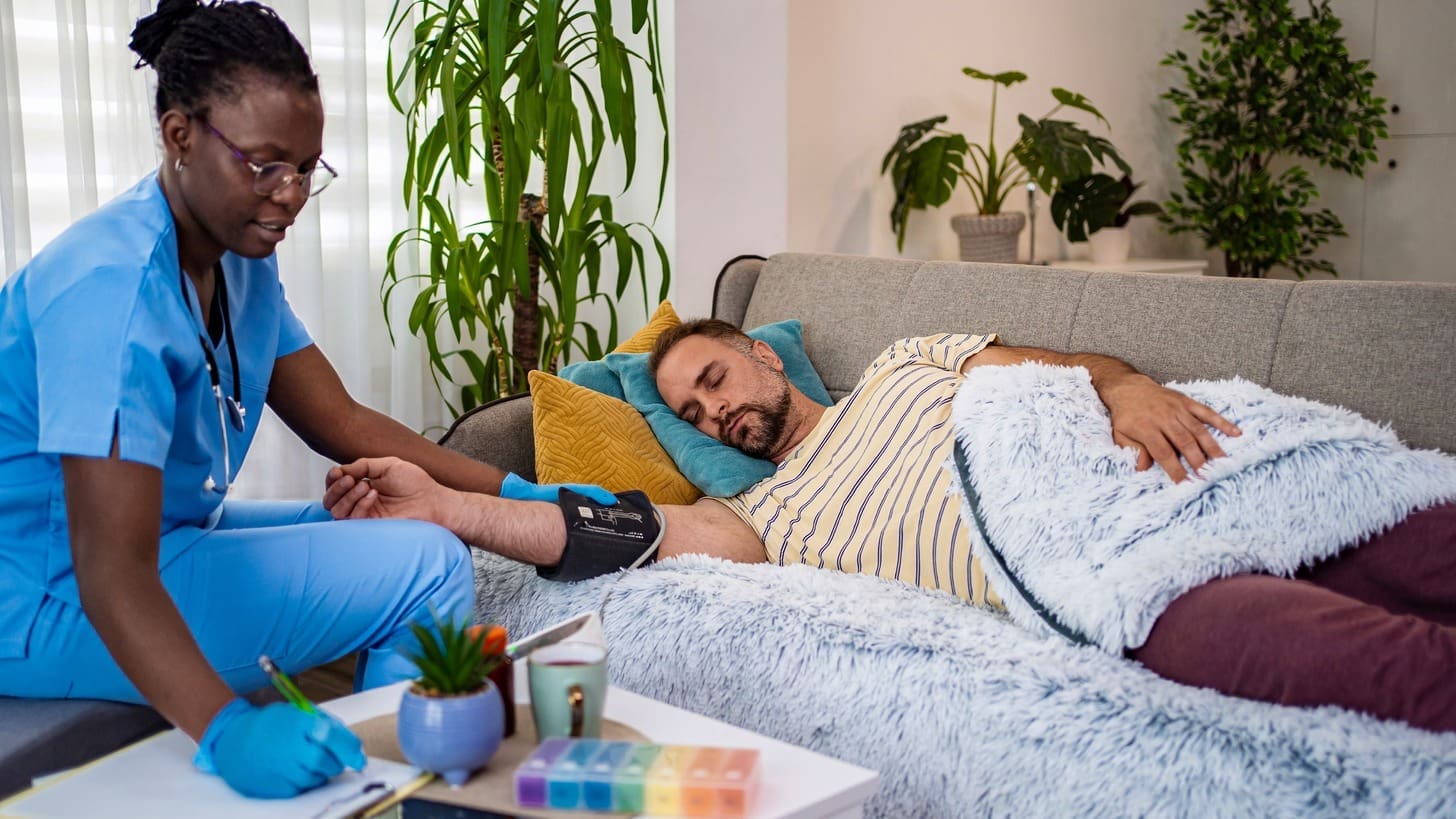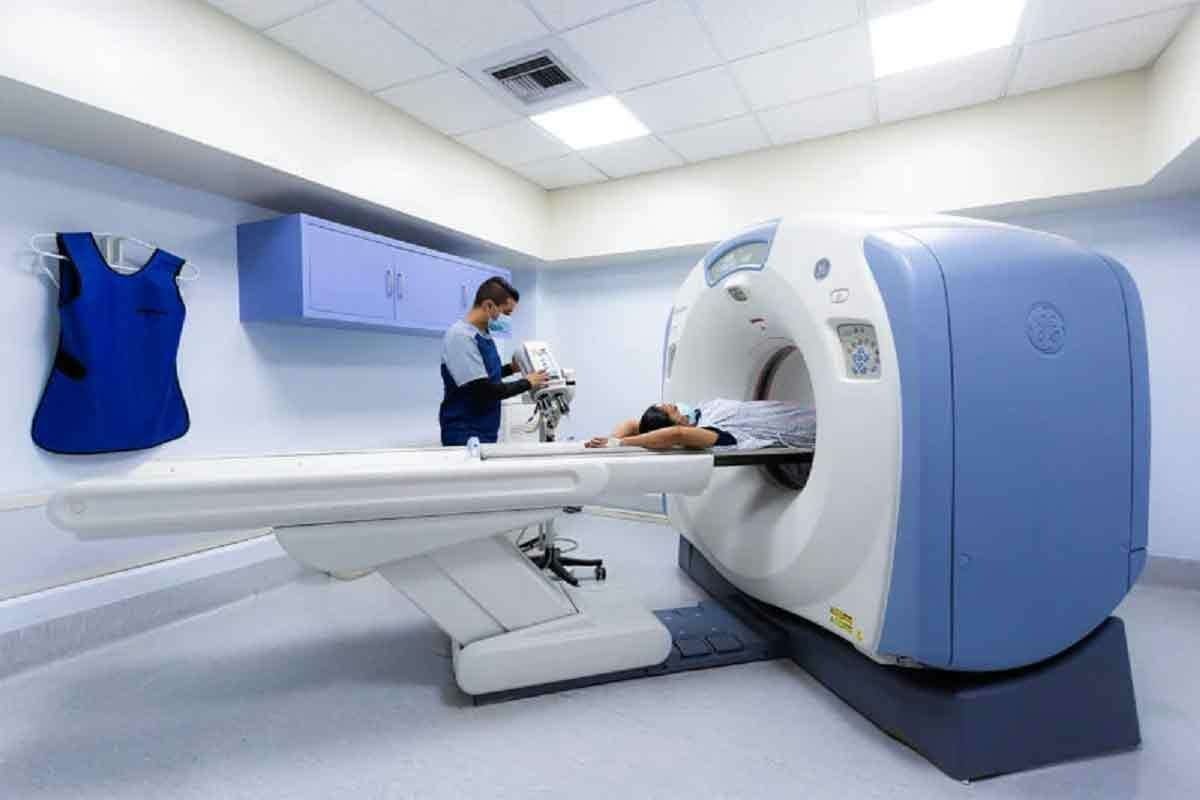Last Updated on November 27, 2025 by Bilal Hasdemir

Cancer treatment is changing fast, with portable chemotherapy solutions leading the way. Studies show that up to 30% of chemotherapy for colorectal cancer is now given outside the hospital.
There’s a big move towards cancer treatment at home. Thanks to devices like the at home chemo pump, patients can get their treatment in their own homes. This makes their experience much better.
At Liv Hospital, we know how important it is to give full care. We make sure patients get the help they need, whether they’re in the hospital or at home.
Key Takeaways
- Chemotherapy can be safely given at home with the right devices.
- Portable chemo pumps make treatment more comfortable and convenient.
- Up to 30% of certain chemotherapy regimens are now managed outside the hospital.
- Comprehensive support is key for patients getting cancer treatment at home.
- Liv Hospital focuses on patient care in cancer treatment.
The Evolution of Outpatient Cancer Treatment
Cancer treatment is changing, with more care happening at home. This change is thanks to new medical tech and the need for more personal and flexible care.
As we move forward in cancer care, it’s key to know why we’re changing. A big reason is the move from only hospital chemotherapy to home treatment.
From Hospital-Only to Home-Based Chemotherapy
Before, chemotherapy was mainly given in hospitals. But now, thanks to portable pumps and other tech, it can be done at home.
Home chemotherapy is getting more popular because it’s convenient and comfortable. Patients can get treatment at home, keeping their lives more normal and independent.
“The ability to receive chemotherapy at home has been a game-changer for many patients, allowing them to undergo treatment in a more comfortable and familiar environment.”
Statistics on Home Chemotherapy Administration
Recent data shows more chemotherapy is being given at home. Up to 30% of colorectal cancer infusions are now at home. This shows a big change in how we treat cancer.
As healthcare gets more innovative, we’ll see more home chemotherapy. This not only improves treatment results but also makes patients’ lives better.
Understanding how outpatient cancer treatment has evolved helps us see the importance of home chemotherapy in today’s care.
What Is an At Home Chemo Pump?
The at home chemo pump is a medical device that changes how chemotherapy is given. It makes treatment more flexible and comfortable for patients. These devices send chemotherapy medication directly into the body over time.
Definition and Purpose
An at home chemo pump is a portable, wearable device for giving chemotherapy at home. Its main goal is to safely and effectively treat patients outside of hospitals. This improves their quality of life.
These pumps are used for many chemotherapy treatments, like 5-Fluorouracil (5FU). They are set to give the right amount of medication at the right time. This ensures patients get the correct dose over their treatment period.
Types of Home Chemotherapy Pumps
There are many types of home chemotherapy pumps, each for different needs. Some common ones are:
- Portable infusion pumps: These are small and can be worn in a pouch or pocket. They let patients move around while being treated.
- Elastomeric pumps: These use a balloon-like reservoir for medication. They are simple and easy to use.
- Programmable pumps: These advanced devices control the rate and timing of medication. They offer flexibility for complex treatments.
Each pump has its own benefits. They are chosen based on the patient’s treatment needs and what they prefer.
How At Home Chemo Pumps Work
At home chemo pumps are changing cancer treatment. They let patients get chemotherapy safely at home. These devices send the medicine into the body in a controlled way.
We’ll look at how these pumps work and how they deliver medicine accurately. The main job of an at home chemo pump is to give chemotherapy at a set rate. This is key for the treatment to work well.
The Mechanics Behind Controlled Medication Delivery
The at home chemo pump uses advanced tech to keep the medicine flow steady. It combines smart design and engineering to do this.
Key components include:
- A reservoir to hold the chemotherapy medication
- A pumping mechanism to deliver the medication
- A control system to regulate the infusion rate
For more info on using an at home chemo pump, check out this guide on managing treatment.
Connection to Central Lines and Ports
At home chemo pumps connect to a central line or port. This gives direct access to the bloodstream. It makes sure the medicine is delivered safely and efficiently.
Using central lines and ports is common in chemotherapy. It helps avoid problems with regular IV lines.
| Connection Type | Description | Benefits |
|---|---|---|
| Central Line | A catheter placed into a large vein | Reduced risk of medication leakage |
| Port | A subcutaneous reservoir | Lower risk of infection |
Infusion Rate Control Mechanisms
The infusion rate control is key in at home chemo pumps. It makes sure the medicine is given at the right rate.
Experts say, “The precision in infusion rate control is vital for the effectiveness and safety of chemotherapy treatment.”
“The ability to control the infusion rate accurately is critical in chemotherapy. It affects the treatment’s success and the patient’s quality of life.”
At home chemo pumps use advanced tech for this precision. They offer a safe and reliable treatment option for patients.
The Setup Process for At Home Chemo Pump Treatment
Setting up at-home chemotherapy is a detailed process. It’s designed to keep patients safe and effective. We help patients through this to avoid problems and get the most from their treatment.
Initial Clinical Preparation
Before starting at-home chemo pump treatment, initial clinical preparation is key. We check the patient’s medical history and current health. We also look at the chemotherapy needs.
We do tests and evaluations to make sure the patient is ready. We teach patients and their caregivers about chemotherapy and its side effects. This helps them manage their treatment better.
Port Access and Pump Connection
Accessing the port and connecting it to the chemo pump needs care. We make sure the port is accessed right and the pump is connected securely. This prevents problems during treatment.
Programming and Activation
After connecting the pump, we program the device for the patient’s treatment. We set the dosage, infusion rate, and treatment time. Our team checks that the pump is working right and safety features are on.
To show the setup steps, here’s a table:
| Step | Description | Responsible Party |
|---|---|---|
| 1. Initial Clinical Preparation | Medical assessment and patient education | Healthcare Team |
| 2. Port Access | Accessing the port for chemotherapy administration | Trained Healthcare Professional |
| 3. Pump Connection | Connecting the chemo pump to the accessed port | Trained Healthcare Professional |
| 4. Programming and Activation | Programming the pump and starting treatment | Trained Healthcare Professional |
By following these steps, we make sure the setup for at-home chemo pump treatment is safe and effective. This lets patients get their chemotherapy at home.
Common Medications Administered via At Home Chemo Pumps
At home chemo pumps make getting chemotherapy easier and more comfortable. They are made to safely give out different chemotherapy drugs.
5-Fluorouracil (5FU) Administration
5-Fluorouracil (5FU) is a common drug given through these pumps. It helps treat cancers like colorectal, breast, and skin cancers. The pump controls how much 5FU is given over 46 to 48 hours. This helps it work better and reduce side effects.
5FU administration needs careful setup and watching to get the right dose. Patients and their helpers learn how to use the pump and solve any problems that come up.
Other Chemotherapy Drugs Suitable for Home Infusion
Other drugs like doxorubicin, irinotecan, and oxaliplatin can also be given at home. These drugs treat different cancers. Whether a drug is good for home use depends on its type, the patient’s health, and the treatment plan.
We team up with doctors to pick the best treatment for each patient. Using at home chemo pumps lets patients get care at home. This makes their life better during treatment.
Why 5FU Is Typically Given Over 46-48 Hours
We look into why 5FU is given over 46-48 hours. This is because of its pharmacological benefits. The extended infusion of 5FU is key in chemotherapy, mainly for some cancers.
Pharmacological Benefits of Extended Infusion
Administering 5FU over 46-48 hours is based on its action and how it’s broken down. 5FU is an antimetabolite that stops DNA synthesis in cancer cells. This slows down cancer cell growth.
Extended infusion keeps drug levels steady. This makes 5FU more effective against cancer cells. It also lowers the risk of severe side effects.
Maximizing Effectiveness While Minimizing Side Effects
5FU given over 46-48 hours boosts its effectiveness and reduces side effects. A controlled infusion rate lowers the risk of severe side effects like mouth sores and low blood counts.
Clinical evidence shows that extended infusion of 5FU has fewer side effects than quick injections. This is good for patients, as it makes treatment better.
Research Supporting the 46-Hour Protocol
Many studies have looked into the best way to give 5FU. Most agree on the 46-48 hour infusion. This time is right for fighting cancer without too much harm.
A study in a top oncology journal found better results and less harm with 46-hour infusions. This study backs up guidelines for giving 5FU this way.
Living With an At Home Chemo Pump
Using an at-home chemo pump means making some changes to your daily life. But with the right help, you can handle treatment easily. We know that getting chemo at home can be tough. Yet, with the right support and info, you can keep living well.
Daily Activities During Treatment
Most people can keep up with their daily tasks while getting chemo at home. It’s key to mix treatment needs with daily life for a smooth process. Talk to your doctor about your daily life to see if you need to make any changes.
You can usually keep working, exercising, and doing hobbies. Just remember to avoid heavy lifting or bending to keep your central line safe. Also, listen to your body and take breaks to rest.
Sleeping, Bathing, and Mobility Considerations
When you have a chemo pump at home, sleeping, bathing, and moving around need special care. Your doctor will tell you how to do these safely to avoid problems.
- Sleeping: You can sleep normally, but try not to lie on the side with the pump to avoid discomfort or dislodging the central line.
- Bathing: You can bathe, but don’t get the pump or central line wet. Use a waterproof cover or bag to keep it dry.
- Mobility: You can move around as needed, but be careful not to bump the pump or tug on the tubing.
Managing the Pump Throughout the Treatment Cycle
Looking after your chemo pump means checking it often, watching for side effects, and keeping your central line or port clean. We teach you how to use your pump and what to do in emergencies.
| Task | Frequency | Responsibility |
|---|---|---|
| Check pump status | Daily | Patient/Caregiver |
| Monitor for side effects | Continuous | Patient/Caregiver |
| Maintain central line/port | As instructed | Patient/Caregiver |
| Replace pump batteries | As needed | Patient/Caregiver |
By following these tips and staying informed, you can manage your chemo treatment at home well. This way, you can keep up with your daily life with little disruption.
Safety Protocols and Monitoring
When using at-home chemotherapy pumps, safety is key. It’s important for patients and caregivers to be well-informed. This helps reduce risks and makes treatment more effective.
Training for Patients and Caregivers
Training is essential for safe use of at-home chemo pumps. We offer detailed training. It covers how to use the pump, handle issues, and what to do in emergencies.
a top oncologist, says, “Education is the key to safe at-home chemotherapy. Patients and caregivers must know how to use the equipment and handle emergencies.”
Our training includes:
- Understanding the pump’s alarm system
- Recognizing and responding to side effects
- Proper maintenance and troubleshooting
Emergency Procedures
Even with precautions, emergencies can happen. We stress the need for being ready for them. Patients and caregivers learn to spot and handle issues like pump malfunctions or medication reactions.
Having a plan for emergencies is vital. A patient shared, “Knowing what to do in an emergency gave me the confidence to keep my treatment at home.”
When to Contact Healthcare Providers
Knowing when to call for medical help is key. We teach patients and caregivers about signs that mean they should contact healthcare providers. This includes unusual side effects, pump errors, or concerns about treatment.
“It’s better to err on the side of caution when it comes to your health. If you’re unsure about any part of your treatment, don’t hesitate to reach out to your healthcare team.”
By being proactive and prepared, patients can safely manage their at-home chemotherapy. This reduces risks and enhances the benefits of their care.
Benefits of Using At Home Chemo Pumps
At-home chemotherapy pumps are changing cancer treatment for the better. They offer many benefits to patients. These devices make cancer care more focused on the patient.
Psychological Advantages of Home Treatment
Getting chemotherapy at home has big mental benefits. Being in a familiar place can lower stress and anxiety. Patients feel more at ease and in control at home, with family nearby.
This comfort boosts mental health and treatment outlook. Family can also help with care, adding emotional support.
Maintaining Normal Routines During Cancer Treatment
At-home chemo pumps let patients keep up with daily life. They can work, enjoy hobbies, or spend time with family while following health team advice.
This helps patients stay connected to their lives and identity. It’s key for their overall health and well-being.
Potential Challenges and Solutions
At-home chemo pumps have many benefits, but patients may face some challenges. We help patients manage these issues to make treatment smoother.
Common Technical Issues With Pumps
At-home chemo pumps can have problems like alarm malfunctions, infusion rate inaccuracies, and pump battery failures. We teach patients and caregivers how to fix these issues.
- Understanding alarm signals and knowing when to pause or stop the infusion
- Regularly checking the pump’s battery level and having a backup plan
- Identifying and addressing possible issues with the infusion set
Knowing about these technical issues helps patients avoid treatment interruptions.
Managing Side Effects at Home
Managing side effects is key when doing chemotherapy at home. Common side effects include nausea, fatigue, and local reactions at the infusion site. We teach patients how to handle these side effects.
- Maintaining a symptom journal to track side effects
- Using anti-nausea medications before they start
- Using techniques to manage fatigue, like pacing and resting
By being proactive, patients can lessen the impact of side effects on their daily lives.
Support Resources for Patients
It’s important for patients to have support when doing chemotherapy at home. We offer 24/7 support hotlines and online resources. We also encourage patients to ask their healthcare team for help.
With these support resources, patients can feel more confident and in control during their treatment.
Conclusion: The Future of At-Home Cancer Treatment
Medical technology is advancing fast, making at-home cancer treatment more advanced. At-home chemo pumps have changed how patients get chemotherapy. Now, they can do it from home, feeling more comfortable.
We’ve looked at how at-home chemo pumps work, how to set them up, and their benefits. These include fewer hospital visits and lower healthcare costs. The future of at-home cancer treatment is bright, with new advancements expected to help patients more.
More and more patients are choosing chemotherapy at home. As technology gets better, we’ll see even more new ways to treat cancer at home. This will make life better for those fighting cancer.
FAQ
What is an at home chemo pump and how does it work?
An at home chemo pump is a device for giving chemotherapy at home. It sends medication through a special system. This system is connected to a central line or port, making sure the right amount of medicine is given.
What types of chemotherapy medications can be administered using an at home chemo pump?
You can use an at home chemo pump for many chemotherapy drugs. One common drug is 5-Fluorouracil (5FU), used to treat some cancers.
Why is 5FU typically given over 46-48 hours?
Giving 5FU for 46-48 hours helps it work better and causes fewer side effects. Studies show this longer time can lead to better treatment results.
How do I manage daily activities while using an at home chemo pump?
Using an at home chemo pump means making some changes to your daily life. You can keep up with your routine by being careful when sleeping, bathing, or moving. Always follow what your healthcare team tells you.
What safety protocols should I follow when using an at home chemo pump?
Safety is key when using an at home chemo pump. You and your caregivers need to learn how to use it safely. Know what to do in an emergency and when to call your healthcare team.
What are the benefits of using an at home chemo pump?
At home chemo pumps have many benefits. They reduce hospital visits and lower costs. They also help you keep up with your daily life while getting treatment.
What kind of support resources are available for patients using at home chemo pumps?
There are many resources for patients with at home chemo pumps. You can get help from healthcare providers, educational materials, and support groups. They can help you deal with challenges and side effects.
Can I travel or move around while using an at home chemo pump?
Yes, many at home chemo pumps are portable. This means you can move around and travel while getting treatment. Just make sure to follow your healthcare team’s advice and take the right precautions.
How do I manage technical issues with my at home chemo pump?
If you have any technical problems with your at home chemo pump, call your healthcare provider or the pump’s support team. Regular checks and maintenance can also help avoid problems.
Can I use an at home chemo pump for other types of chemotherapy medications?
At home chemo pumps can be used for different chemotherapy drugs. But, the specific drug and treatment plan will depend on your needs and what your healthcare provider recommends.
What is an at home chemo pump and how does it work?
An at home chemo pump is a device for giving chemotherapy at home. It sends medication through a special system. This system is connected to a central line or port, making sure the right amount of medicine is given.
What types of chemotherapy medications can be administered using an at home chemo pump?
You can use an at home chemo pump for many chemotherapy drugs. One common drug is 5-Fluorouracil (5FU), used to treat some cancers.
Why is 5FU typically given over 46-48 hours?
Giving 5FU for 46-48 hours helps it work better and causes fewer side effects. Studies show this longer time can lead to better treatment results.
How do I manage daily activities while using an at home chemo pump?
Using an at home chemo pump means making some changes to your daily life. You can keep up with your routine by being careful when sleeping, bathing, or moving. Always follow what your healthcare team tells you.
What safety protocols should I follow when using an at home chemo pump?
Safety is key when using an at home chemo pump. You and your caregivers need to learn how to use it safely. Know what to do in an emergency and when to call your healthcare team.
What are the benefits of using an at home chemo pump?
At home chemo pumps have many benefits. They reduce hospital visits and lower costs. They also help you keep up with your daily life while getting treatment.
What kind of support resources are available for patients using at home chemo pumps?
There are many resources for patients with at home chemo pumps. You can get help from healthcare providers, educational materials, and support groups. They can help you deal with challenges and side effects.
Can I travel or move around while using an at home chemo pump?
Yes, many at home chemo pumps are portable. This means you can move around and travel while getting treatment. Just make sure to follow your healthcare team’s advice and take the right precautions.
How do I manage technical issues with my at home chemo pump?
If you have any technical problems with your at home chemo pump, call your healthcare provider or the pump’s support team. Regular checks and maintenance can also help avoid problems.
Can I use an at home chemo pump for other types of chemotherapy medications?
At home chemo pumps can be used for different chemotherapy drugs. But, the specific drug and treatment plan will depend on your needs and what your healthcare provider recommends.
References
Healthline. What Is a Chemotherapy Pump? https://www.healthline.com/health/cancer/chemotherapy-pump
Medical News Today. Chemo Pump: Definition and How They Work. https://www.medicalnewstoday.com/articles/chemo-pump
U.S. Food and Drug Administration (FDA). Infusion Pumps: Tips for Using Your Pump at Home. https://www.fda.gov/medical-devices/infusion-pumps/infusion-pumps-tips-using-your-pump-home








